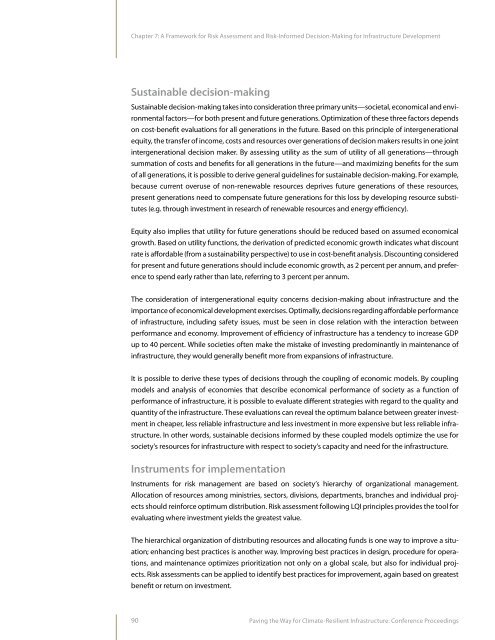Paving the Way for Climate-Resilient Infrastructure - UN CC:Learn
Paving the Way for Climate-Resilient Infrastructure - UN CC:Learn
Paving the Way for Climate-Resilient Infrastructure - UN CC:Learn
You also want an ePaper? Increase the reach of your titles
YUMPU automatically turns print PDFs into web optimized ePapers that Google loves.
Chapter 7: A Framework <strong>for</strong> Risk Assessment and Risk-In<strong>for</strong>med Decision-Making <strong>for</strong> <strong>Infrastructure</strong> DevelopmentSustainable decision-makingSustainable decision-making takes into consideration three primary units—societal, economical and environmentalfactors—<strong>for</strong> both present and future generations. Optimization of <strong>the</strong>se three factors dependson cost-benefit evaluations <strong>for</strong> all generations in <strong>the</strong> future. Based on this principle of intergenerationalequity, <strong>the</strong> transfer of income, costs and resources over generations of decision makers results in one jointintergenerational decision maker. By assessing utility as <strong>the</strong> sum of utility of all generations—throughsummation of costs and benefits <strong>for</strong> all generations in <strong>the</strong> future—and maximizing benefits <strong>for</strong> <strong>the</strong> sumof all generations, it is possible to derive general guidelines <strong>for</strong> sustainable decision-making. For example,because current overuse of non-renewable resources deprives future generations of <strong>the</strong>se resources,present generations need to compensate future generations <strong>for</strong> this loss by developing resource substitutes(e.g. through investment in research of renewable resources and energy efficiency).Equity also implies that utility <strong>for</strong> future generations should be reduced based on assumed economicalgrowth. Based on utility functions, <strong>the</strong> derivation of predicted economic growth indicates what discountrate is af<strong>for</strong>dable (from a sustainability perspective) to use in cost-benefit analysis. Discounting considered<strong>for</strong> present and future generations should include economic growth, as 2 percent per annum, and preferenceto spend early ra<strong>the</strong>r than late, referring to 3 percent per annum.The consideration of intergenerational equity concerns decision-making about infrastructure and <strong>the</strong>importance of economical development exercises. Optimally, decisions regarding af<strong>for</strong>dable per<strong>for</strong>manceof infrastructure, including safety issues, must be seen in close relation with <strong>the</strong> interaction betweenper<strong>for</strong>mance and economy. Improvement of efficiency of infrastructure has a tendency to increase GDPup to 40 percent. While societies often make <strong>the</strong> mistake of investing predominantly in maintenance ofinfrastructure, <strong>the</strong>y would generally benefit more from expansions of infrastructure.It is possible to derive <strong>the</strong>se types of decisions through <strong>the</strong> coupling of economic models. By couplingmodels and analysis of economies that describe economical per<strong>for</strong>mance of society as a function ofper<strong>for</strong>mance of infrastructure, it is possible to evaluate different strategies with regard to <strong>the</strong> quality andquantity of <strong>the</strong> infrastructure. These evaluations can reveal <strong>the</strong> optimum balance between greater investmentin cheaper, less reliable infrastructure and less investment in more expensive but less reliable infrastructure.In o<strong>the</strong>r words, sustainable decisions in<strong>for</strong>med by <strong>the</strong>se coupled models optimize <strong>the</strong> use <strong>for</strong>society’s resources <strong>for</strong> infrastructure with respect to society’s capacity and need <strong>for</strong> <strong>the</strong> infrastructure.Instruments <strong>for</strong> implementationInstruments <strong>for</strong> risk management are based on society’s hierarchy of organizational management.Allocation of resources among ministries, sectors, divisions, departments, branches and individual projectsshould rein<strong>for</strong>ce optimum distribution. Risk assessment following LQI principles provides <strong>the</strong> tool <strong>for</strong>evaluating where investment yields <strong>the</strong> greatest value.The hierarchical organization of distributing resources and allocating funds is one way to improve a situation;enhancing best practices is ano<strong>the</strong>r way. Improving best practices in design, procedure <strong>for</strong> operations,and maintenance optimizes prioritization not only on a global scale, but also <strong>for</strong> individual projects.Risk assessments can be applied to identify best practices <strong>for</strong> improvement, again based on greatestbenefit or return on investment.90<strong>Paving</strong> <strong>the</strong> <strong>Way</strong> <strong>for</strong> <strong>Climate</strong>-<strong>Resilient</strong> <strong>Infrastructure</strong>: Conference Proceedings
















